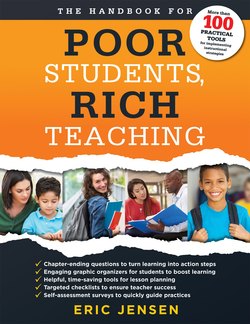Читать книгу The Handbook for Poor Students, Rich Teaching - Eric Jensen - Страница 12
ОглавлениеPART TWO
IMPLEMENTING THE ACHIEVEMENT MINDSET
The achievement mindset asks you a simple question: “Are your students’ brains stuck for the rest of their life at their current cognitive level or can they be lifted?” If their brains are not stuck, then you are invited (and maybe even compelled) to help each student develop his or her drive, effort, and intention. Start with the mindset that every single student can and will learn and then help them learn it. This is a way to frame equity from the conversation to action steps. In this part of the book, you’ll gain strategies and tools to develop steady motivation to help foster student efforts to produce greater achievement by choice. However, before we dig in, let’s start with a quick self-assessment regarding how you approach student achievement in your classroom. See figure P2.1 (page 38).
Many teachers complain that their students lack effort. At the same time, it is a simple fact: a student who appears lazy or unmotivated for one teacher will often work hard for another teacher. This simple fact shows us that the student is different with a different teacher. This is extremely important to keep in mind as you reflect on your answers to these questions. It is the teaching that makes the difference, and the achievement mindset changes everything. The achievement mindset says, “I can build student effort, motivation, and attitudes to succeed. They are all teachable skills.”
The achievement mindset says, “I can build student effort, motivation, and attitudes to succeed. They are all teachable skills.”
I sometimes hear teachers say things like, “By this grade, they should be able to motivate themselves. If they can’t do it, they’re not going to make it anyway.” If you blame the students, parents, or your circumstances and make every teaching problem someone else’s fault, you’re stuck as a professional and won’t get better. But if you choose to help your students succeed, you’ll bravely hold up a mirror. The mirror reminds all of us, “If it’s to be, it’s up to me.” The achievement mindset shows that when the conditions are right every one of us can and will achieve.
Figure P2.1: Assess your understanding of how poverty affects student achievement.
Visit go.SolutionTree.com/instruction for a free reproducible version of this figure.
Think about your current approach to students’ successes and failures. When students succeed, you’ll want to consistently attribute it to their preparation, effort, planning, strategies, focus, positive attitude, and persistence—elements under a student’s control. Therefore, when students fail, avoid using comfort words for failure, like “You tried so hard” or “At least you have other strengths.” These are detrimental, and when you use phrases like these, it lowers the student’s expectations of himself or herself, motivation drops, and the student actually does worse (Rattan, Good, & Dweck, 2012).
You can learn even more about the full scope of research backing the achievement mindset in Poor Students, Rich Teaching, Revised Edition (Jensen, 2019); for our purposes, your three main takeaways are the following.
1. Learn the invisible motivators: Our brain is designed to pick up countless social, physical, and linguistic cues, which I narrow down to the following five: (1) approach, frame, and define a task appropriately; (2) manage the self-talk from you and the student; (3) provide core background subskills needed for the task; (4) identify stereotype threats and remove them; and (5) frame failures so students grow from them.
2. Foster a growth mindset in your students: Put simply, an achievement mindset is teachable. Lisa Blackwell, Kali Trzesniewski, and Carol Dweck (2007) found that students taught with a growth mindset outperformed a control group on test scores and had more effort and interest over three times as often.
3. Drop the labels: Avoid labels like minority students (Latino, African American, and Asian students make up 50.3 percent of U.S. public K–12 classrooms; Maxwell, 2014), low achievers or low students (these terms imply some sort of deficit when the truth is that the student may have had underperforming teachers for several years), and disadvantaged or disabled students (students from poverty are more likely to be school dependent for their enrichment, and many are inappropriately labeled as disabled).
The upcoming chapters dig into three of the most effective achievement boosters of all time. There is no ascending or descending order of importance. In fact, these ideas play off each other with a synergistic effect.
1. Set gutsy goals.
2. Give fabulous feedback.
3. Persist with grit.
Be patient in building the class campfire of energy. Every spark you bring to the classroom campfire will build the student fires of desire. The content you teach might remain the same; however, the circumstances for learning, your context, and your strategies can create highly motivated students, if you know how to do it. Get psyched!
Questions for Daily Reflection
Each day, consider your own mindset for helping students approach their learning with the conviction that they can achieve academic success, regardless of any challenges they have outside of school. Then, answer the following questions.
1. What can I do today to ensure I help a student who is struggling to overcome an academic obstacle and have success?
2. What big-picture goals have I set for my students, and how are they progressing toward that goal? What micro goal will I help them achieve on this day?
3. Have I given my students the feedback they need to improve and overcome mistakes? What can I do better?
